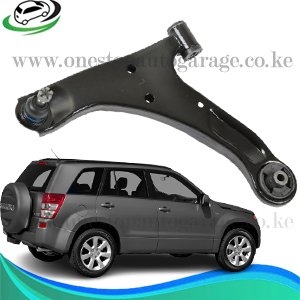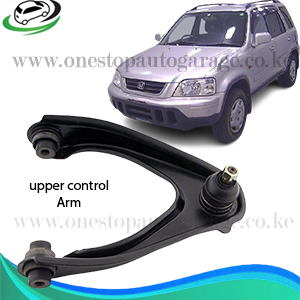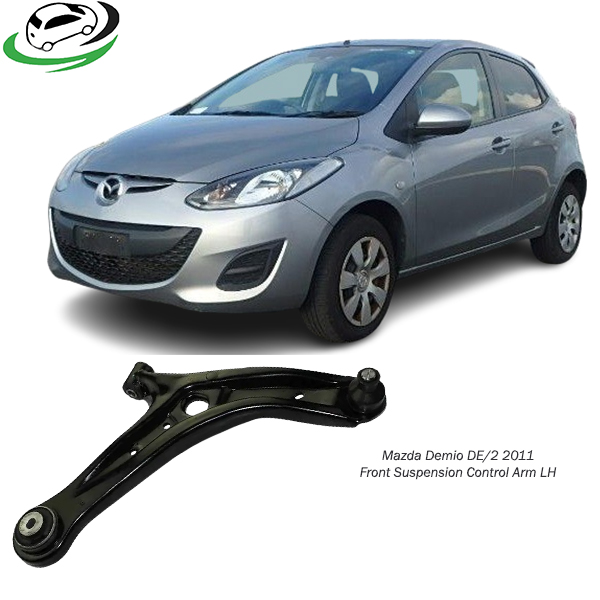-10%
Get Mazda Demio DE/2 2011 Front Suspension Control Arm LH D651-34-350D
The front suspension control arm, often referred to as the “A-arm” or simply “control arm,” is a critical component of a vehicle’s suspension system. It serves as the pivot point connecting the vehicle’s wheels to its chassis, enabling movement and stability. The left-hand (LH) control arm on the driver’s side is particularly significant as it is often exposed to the greatest amount of wear and tear due to road camber and the positioning of the driver. Let’s delve into a comprehensive overview of the front suspension control arm, its structure, functions, benefits, common issues, and maintenance tips.
1. Structure and Components of the Front Suspension Control Arm (LH)
The left-hand control arm typically has a triangular shape, with two main points that attach to the chassis and a single point connecting to the wheel hub assembly. Its primary purpose is to keep the wheels in alignment with the car’s frame while allowing for vertical movement as the wheels encounter bumps and dips in the road.
- Ball Joint: At the end of the control arm, a ball joint connects the arm to the wheel hub. The ball joint allows the wheel to move up and down while providing rotational flexibility, enabling smooth steering and turning.
- Bushings: Control arms are equipped with rubber or polyurethane bushings at the points where they attach to the frame. These bushings absorb shock and vibration, preventing direct metal-to-metal contact that could cause premature wear or damage.
- Metal Arm: The actual arm is typically made from steel or aluminum. Steel control arms are durable but heavy, whereas aluminum is lighter and resists corrosion better, though it may not be as strong as steel.
2. Function of the Front Suspension Control Arm (LH)
The left-hand front suspension control arm’s primary role is to maintain wheel alignment relative to the vehicle’s frame. Here’s how it accomplishes this:
- Maintaining Proper Wheel Alignment: The control arm holds the wheels at the correct angle and position relative to the body. This ensures that the wheels remain in optimal alignment, minimizing tire wear and maintaining handling precision.
- Absorbing Road Shocks and Vibrations: Control arms, with their bushings and joints, absorb shocks and vibrations from the road. This helps isolate these forces from the car’s frame and cabin, contributing to a smoother, quieter ride.
- Enabling Smooth Steering and Suspension Movement: With the ball joint and bushings, the control arm enables smooth up-and-down movement as well as lateral movement needed for steering. The control arm allows the wheel to pivot and turn with the driver’s steering input.
- Stabilizing the Vehicle: The control arm adds stability to the vehicle by controlling the movement of the suspension and helping to distribute load across the chassis. This enhances overall handling, especially during braking and turning maneuvers.
3. Benefits of a Well-Maintained Front Suspension Control Arm (LH)
Maintaining the control arm in good condition yields significant benefits for the vehicle’s performance and longevity:
- Enhanced Ride Comfort: With functional bushings and ball joints, the control arm effectively absorbs road imperfections, delivering a smoother ride experience. This reduces fatigue on both the vehicle’s occupants and suspension components.
- Better Handling and Stability: A properly functioning control arm keeps the wheels aligned, allowing for precise handling and stability. This makes steering easier and safer, particularly when maneuvering or driving at high speeds.
- Reduced Tire Wear: Proper wheel alignment, maintained by the control arm, ensures even tire wear, extending tire life and improving fuel efficiency. Uneven or premature tire wear can be minimized with a stable and aligned control arm.
- Minimized Wear on Suspension Components: By absorbing and distributing forces, a well-maintained control arm reduces the strain on other suspension parts, including shocks, struts, and the chassis itself. This helps prevent premature failure of these components.
- Improved Safety: Control arms contribute to vehicle safety by keeping the wheels stable and the vehicle in control. A worn or damaged control arm could lead to compromised handling, increasing the risk of accidents, particularly in emergency maneuvers or adverse road conditions.
4. Signs of a Worn or Failing Front Suspension Control Arm (LH)
Over time, the control arm and its components can wear down due to exposure to road debris, extreme temperatures, and the stress of daily driving. Here are some common signs that indicate a failing left-hand control arm:
- Clunking or Knocking Noises: One of the most common signs of a bad control arm is a clunking or knocking sound when driving over bumps or rough roads. This can be caused by worn-out bushings or a loose ball joint.
- Vibrations in the Steering Wheel: Worn bushings or a faulty ball joint can cause vibrations in the steering wheel, particularly at higher speeds or when braking.
- Uneven or Rapid Tire Wear: If the control arm is compromised, it can lead to poor wheel alignment, resulting in uneven or accelerated tire wear. This is often most visible on the inner or outer edges of the tires.
- Steering Instability: A failing control arm may cause the vehicle to wander or pull to one side, making it difficult to maintain a straight line. This can also result in “play” in the steering wheel, leading to handling imprecision.
- Poor Ride Quality: If the bushings are worn or damaged, they may not absorb road imperfections effectively, leading to a rougher, less comfortable ride.
5. Maintenance Tips for the Front Suspension Control Arm (LH)
Regular inspection and maintenance of the control arm can extend its life and ensure safe driving. Here are some maintenance tips:
- Regular Inspection: Periodically inspect the control arm for any signs of rust, damage, or worn bushings and ball joints. Regular check-ups during routine service can help identify issues early before they lead to more serious problems.
- Check Wheel Alignment: Improper wheel alignment can place added stress on the control arm and its bushings. Ensure that wheel alignment is checked and adjusted as needed, particularly if you notice uneven tire wear.
- Lubricate Ball Joints (If Applicable): Some ball joints are sealed and do not require lubrication, while others may need periodic greasing. Proper lubrication can extend the life of the ball joint and improve control arm performance.
- Replace Bushings When Worn: If the control arm bushings show signs of wear, cracks, or splitting, replace them with high-quality rubber or polyurethane alternatives. Polyurethane bushings are more durable but may result in a firmer ride, while rubber bushings provide a softer, quieter ride.
- Avoid Overloading the Vehicle: Excessive weight can place undue stress on the suspension, leading to accelerated wear of the control arm. Avoid exceeding the vehicle’s weight limits to reduce strain on the suspension system.
6. Replacement and Cost of the Front Suspension Control Arm (LH)
If the control arm is significantly damaged or the bushings and ball joint are excessively worn, replacement may be necessary. Here’s what to consider:
- Replacement Process: Replacing a control arm involves removing the wheel, disconnecting the ball joint and bushings, and installing a new arm. It can be a complex procedure and generally requires professional assistance.
- Cost of Replacement: The cost of a control arm replacement varies based on the vehicle model and labor rates. A control arm may cost between $50 and $150, while labor can add another $150 to $300.
- DIY Replacement: While some enthusiasts attempt to replace control arms themselves, it requires specific tools and knowledge of suspension systems. It’s often best to leave this job to a professional to ensure proper installation.
7. Choosing a Quality Front Suspension Control Arm (LH)
When selecting a replacement control arm, consider the following factors to ensure durability and performance:
- Material Quality: Steel and aluminum are the most common materials. Steel offers more strength, while aluminum provides lighter weight and better corrosion resistance.
- Brand Reputation: Reputable brands usually provide control arms with warranties, giving assurance of quality and longevity. Trusted brands may also offer parts with enhanced features, such as pre-lubricated ball joints or reinforced bushings.
- Compatibility: Ensure that the control arm is specifically designed for your vehicle’s make and model to guarantee proper fitment and alignment.
8. Conclusion
The left-hand front suspension control arm is essential for vehicle stability, handling, and ride comfort. It acts as a stabilizing pivot between the wheel and chassis, allowing the wheel to move with the road while keeping the vehicle body aligned. Regular inspections, proper maintenance, and timely replacement of worn components can extend the lifespan of the control arm and maintain optimal vehicle performance.
A functional front suspension control arm ensures safe, responsive handling and a smoother ride, while worn or damaged control arms can negatively impact alignment, steering, and safety. By investing in quality control arms and keeping them in good condition, you can enjoy a comfortable, reliable driving experience with minimal disruption.
Follow us on Facebook for more parts.



